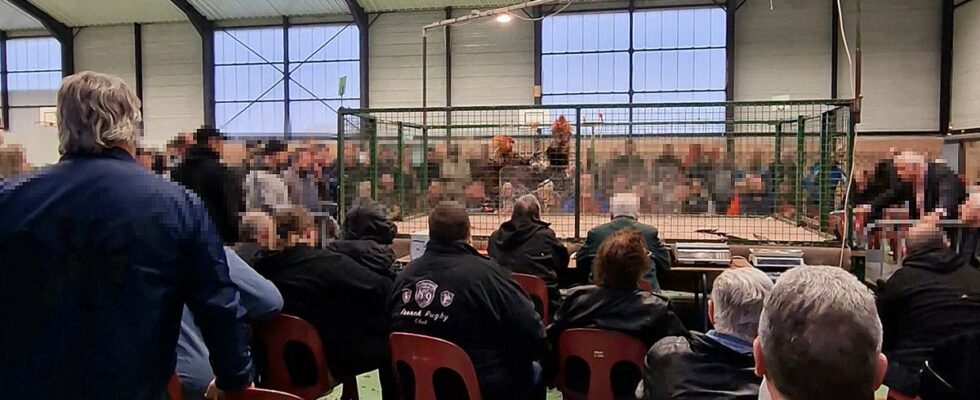In Nord-Pas-de-Calais too, we have traditions: welsh, carnival and cockfighting. If the first two are unanimous, it is much less true for the last, so much so that this practice was thought to be extinct. This is not the case, and if the tradition continues, it is nevertheless discreet. It is also thanks to a call to demonstrate from the animalist party that we learned of the organization of fights on Saturday in Beuvry-la-Forêt, in the North. Inevitably, we wanted to go see. Reporting.
Gallodromes, there are still a few in the Nord-Pas-de-Calais, but on Saturday, it was in the middle of a sports hall that the arena, or rather the park, was set up. At the entrance, we are stamped on our hands with blue ink once the amount of the ticket has been paid: three euros. Immediately to the right, on trestle tables, the bar. On the left, behind some screens, we can imagine from the cries emanating from it that this is where everything is played out. But before entering the park, you have to go along the “armament zone”, the place where the “cocklers” equip their fighters with gaffs, kinds of sharp metal spurs, fixed on the lugs of the birds.
For bets, “nothing is written, it’s a matter of words”
Around the park, dozens of spectators or participants have already taken their places. At a glance, we have 98% of men and, in clothing, it is khaki green that dominates. “Many are hunters, like me,” explains Arnaud Delplanque, president of the Société Chasse Place and organizer of the competition. About sixty years old, as far as he can remember, he has always attended fights without taking part in them. “Before, it was the Beuvry football club that organized it, but the leaders decided to stop, he explains. So with a friend, we wanted to take up the torch so that the tradition does not die out. Because on this subject, the law is very clear: cockfighting is prohibited in France, with the exception of Nord-Pas-de-Calais, where it is considered a local tradition. It is still necessary to justify that this tradition is uninterrupted, in other words “that at least one fight per calendar year is organized in the commune so that it retains its authorization”, specifies Arnaud Delplanque.
The cries heard from the entrance were not those of the roosters, but the calls of the bettors gathered around the park. “Five Bernard”, “five Michel”… A cacophony that goes off, at first sight, in all directions for the uninitiated. “In fact, people bet among themselves on the victory of such and such a rooster, explains a spectator. Nothing is written, it is a question of speech. The coqueleux are in the park, their animals in their arms, firmly holding their paws long enough to remove the protections that hide the gaffes. Before releasing them, there is a ritual. “They visit the weapons, each checks if the blunders of the other are in conformity. Afterwards they present the roosters face to face then put them down and must withdraw immediately”, explains an informed amateur to us.
This is where we get into the hard part and where the din of betting takers stops. It usually only takes a few seconds for the fighters to pounce on each other. “Hit it, but hit it, pickle,” shouts a sixty-year-old man in combat fatigues. Quite rare “encouragement” however, the atmosphere during the fights being rather strangely silent. The only noise comes from the roosters themselves, in their movements to slaughter. That and feathers flying all over the place. Quickly, the fighters are out of breath, exhausted, panting, lying on their sides for a short rest. Until one of them pounces on his opponent again. If one gets the upper hand, it will peck at the other’s head until death ensues. “The judges can stop the fight if a rooster is injured or dead”, recognizes the organizer. In fact, several died there before the end of the five regulatory minutes.
Ban on filming and photographing the fights
Throughout the afternoon, the clashes were linked. “Parties”, prefer to say the coqueleux. Just as we do not say of a rooster that he fights, but that he “plays”. Euphemisms to hide what animal defenders call a barbaric practice? “Yes, it may be a little cruel, concedes one of the organizers. But this is nothing compared to what is done in factory farms”, he insists to from a BFM colleague, forbidden to film the fights. They recognize it, this question is a little delicate, so we were advised against presenting ourselves as journalists and taking photos. A rule that aficionados apply to themselves. We have to realize that images of a park stained with blood from which featherless animals come out in a sorry state would not serve their cause.
On Saturday, there will have been 42 fights, a lot of money exchanged and an impossible death toll. The roosters who left their lives there will be eaten by their owners, “we’re not going to throw them in the trash anyway”, indignantly a participant. The others, provided that they are not in too bad a condition, will be treated with a view to fighting in a future contest. “There is one, last year, he won eight fights at not even three years old,” assures us a forty-year-old. The star of the moment who excites bettors but whose end in nuggets or net is written in advance.

